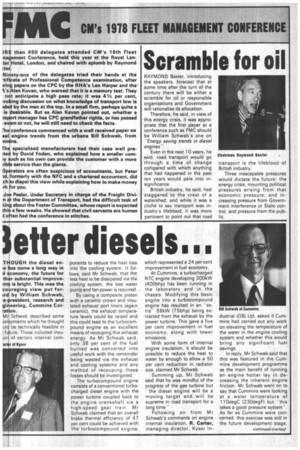etter diesels...
Page 31

Page 32

If you've noticed an error in this article please click here to report it so we can fix it.
,T OUGH the diesel enle as come a long way in conomy, the future for .th r substantial improveint is bright. This was the co raging view put forird by William Schwab, !eresident, research and gi eering, Cummins Corrat on.
Mr Schwab described some 'el pments which he thought ul be technically feasible in f ure. These included insuIon of certain internal corn
;art r of Kysor
ponents to reduce the heat loss into the cooling system. It follows, said Mr Schwab, that the less heat to be dissipated via the cooling system, the less water pump and fan power is required.
By using a composite piston with a ceramic crown and Insulated exhaust port liners (again ceramic), the exhaust temperature levels could be raised and this could lead to the turbocompound engine as an excellent means of recouping this exhaust energy. As Mr Schwab said, only 38 per cent of the fuel burned was converted into useful work with the remainder being wasted via the exhaust and cooling systems and any method of recouping these losses should be investigated.
The turbocompound engine consists of a conventional turbocharged diesel engine with the power turbine coupled back to the engine crankshaft via a high-speed gear train. Mr Schwab claimed that an overall brake thermal efficiency of 47 per cent could be achieved with the turbocom pound engine, which represented a 24 per cent improvement in fuel economy.
At Cummins, a turbocharged NTC engine developing 300kW (400bhp) has been running in the laboratory and in the chassis. Modifying this basic engine into a turbocompound engine has resulted in an "extra" 56kW (75bhp) being extracted from the exhaust by the power turbine. This gave a five per cent improvement in fuel economy, along with lower emissions.
With some form of internal engine insulation, it should be possible to reduce the heat to water by enough to allow a 50 per cent reduction in radiator size, claimed Mr Schwab.
Summing up, Mr Schwab said that he was mindful of the progress of the gas turbine but "the diesel engine will be a moving target and will be supreme in road transport for a long time.'" Following on from Mr Schwab's comments on engine internal insulation, R. Carter, managing director, Kysor In dustrial (GB) Ltd, asked if Cummins had carried out any work on elevating the temperature of the water in the engine cooling system and whether this would bring any significant fuel savings.
In reply, Mr Schwab said that this was featured in the Cummins development programme as the main benefit of running an engine hotter lay in decreasing the inherent engine friction. Mr Schwab went on to say that Cummins were looking at a water temperature of 110degC (230degF) but -this takes a good pressure system-. As far as Cummins were concerned, this exercise was still in the future development stage,
but Mr Schwab thought that its future was promising.
One of the problems of exercis'es such as this said Mr Schwab was that there had to be "'a satisfactory trade-off where any gains in fuel economy have to be balanced against the cost of carrying out the modification."
The subject of lubricating oil was raised by C. Williams of Silver Roadways. He asked if there was any major improvement likely in this area, with a view to reducing friction.
In reply, Mr Schwab said that most of the advanced work he had mentioned included run ning at higher temperatures and he thought that this would be the way oil technology would develop — to allow higher temperatures rather than produce better lubrication. At this development stage, Cummins are involved in work using synthetic oils for this purpose, according to Mr Schwab.
"Would Mr Schwab care to predict a figure for engine efficiency in, say, ten years' time?" was the question posed by A. Carmichael, Carmichael Trucks (Worcester) Ltd.
Mr Schwab stressed that the higher the cylinder pressures, the better the efficiency with a figure of 13,790 kN /sqm (2,000psi) being used by Cum mins as a guide line. Using this figure, the air standard cycle gave a maximum theoretical efficiency of around 55 per cent. Mr Schwab thought that maximum efficiencies of round 50 per cent should be possible within the next 10 years.
Representing Shell UK, A. L. Hutchinson, chief engineer, said that it was all very well
making these improvements to the engine, but -it all depends
on the driver's foot" He asked if Cummins consulted the chassis manufacturer to control the human element.
Mr Schwab stressed that driveability was considered of prime importance at Cummins — witness the company's use of a driveability simulator at the Cummins laboratory. He agreed that it was necessary to work with the driver, as he could have a profound effect on the performance of the vehicle.
If the engine was well matched to the drive line, then the driver would find the vehicle easier to drive and the fuel economy would benefit accordingly, claimed Mr Schwab.




























































































































